List of weight training exercises
This is a partial list of weight training exercises organized by muscle group.
Overview
| Exercise | Quad- riceps |
Ham- strings |
Calves | Gluteus | Hips other |
Trapezius | Pectorals | Lats | Deltoids | Triceps | Biceps | fore- arms |
Ab- dominals |
Lower back |
|---|---|---|---|---|---|---|---|---|---|---|---|---|---|---|
| Squat | Yes | Yes | Yes | Yes | Yes | Some |
| |||||||
| Leg press | Some | Yes | Some | Yes |
| |||||||||
| Lunge | Yes | Yes | Yes | Yes |
| |||||||||
| Deadlift | Yes | Yes | Yes |
| ||||||||||
| Leg extension | Yes |
| ||||||||||||
| Leg curl | Yes |
| ||||||||||||
| Standing calf raise | Yes |
| ||||||||||||
| Seated calf raise | Yes |
| ||||||||||||
| Hip adductor | Yes |
| ||||||||||||
| Bench press | Yes | Some | Some |
| ||||||||||
| Chest fly | Yes | Some | Some | Some
| ||||||||||
| Pulldown | Yes | Some | Some | Some
| ||||||||||
| Pull-up | Yes | Some | Some | Some | Some
| |||||||||
| Bent-over row | Yes | Some | Some | Some
| ||||||||||
| Upright row | Some | Yes | Some | Some | Some
| |||||||||
| Shoulder press | Some | Yes | Some |
| ||||||||||
| Shoulder fly | Some | Yes | Some
| |||||||||||
| Pushdown | Yes |
| ||||||||||||
| Triceps extension | Yes |
| ||||||||||||
| Biceps curl | Yes |
| ||||||||||||
| Crunch | Yes |
| ||||||||||||
| Leg raise | Yes | Yes |
| |||||||||||
| Back extension | Yes | Yes |
|
p.s. whoever made this table is an idiot who doesnt know the 1st thing about weights, starting from deadlifts which are a full body excercise which work the lower back immensly, as well as the squat which can be subdivided into front squats, overhead squats and traditional squats, which work the shoulder (overhead) and all squats work the abdominal muscles.
Lower body
Most lower body exercises are best executed with weight machines, although two freeweight exercises – the squat and lunge – constitute an effective lower body routine.[1]
Quadriceps (front of legs)
Squat

The squat is performed by squatting down with a weight held across the upper back and standing up straight again. This is a compound exercise that also involves the glutes (buttocks) and, to a lesser extent, the hamstrings, calves and the lower back. Lifting belts are often used to help support the lower back. The freeweight squat is a challenging exercise and not appropriate for beginners, as poor form or execution can cause serious injury.[2]
- Equipment
- Body weight, barbell, Smith machine or hack squat machine.Other forms of injury resulting in squats is the pain in the back of the neck or trapezius muscle, but this problem can be solved with barbell pad equipment like the Squat Sponge. The squat sponge enhances and allows for proper form for squats and lunges and provides additional comfort for the upper and lower back and abdomen area during said exercises for supporting a barbell during. said back or front squat and lunge exercises. Molded thick foam of varying degrees of open and close cell foam; thickness and density with a grooved center. [3]
- Major variants
- Front (weight across the upper chest); seated squat (standing from a sitting position and returning to sitting position).
Leg press
The leg press is performed while seated by pushing a weight away from the body with the feet. It is a compound exercise that also involves the glutes and, to a lesser extent, the hamstrings and the calves. Overloading the machine can result in serious injury if the sled moves uncontrollably towards the trainer.[4]
- Equipment
- Leg press machine.
Lunge
The lunge is performed by placing one leg in front of the other and then bending the front leg toward a ninety degree angle, so that the knee of the back leg touches the ground, all while holding a dumbbell in each hand.[5] This exercise uses the same muscles as the squat does, but requires less weight, as only one leg is exercised at a time.[5]
- Equipment
- Dumbbells.
- Major Variant
- Barbell lunge (holding a barbell across the back of the neck).
Deadlift

The deadlift is performed by squatting down and lifting a weight off the floor with the hand until standing up straight again. Grips can be face down or opposing with one hand down and one hand up, to prevent dropping. Face up should not be used because this puts excess stress on the inner arms. This is a compound exercise that also involves the glutes, lower back, lats, trapezius (neck) and, to a lesser extent, the hamstrings and the calves. Lifting belts are often used to help support the lower back.
- Equipment
- Dumbbells, barbell, trapbar or Smith machine.
- Major variants
- Sumo (wider stance to emphasise the inner thighs); stiff legged (emphasizes hamstrings); straight-legged deadlift (emphasizes lower back).
Leg extension

The leg extension is performed while seated by raising a weight out in front of the body with the feet. It is an isolation exercise for the quadriceps. Overtraining can cause patellar tendinitis.[6]
- Equipment
- Dumbbell, cable machine or leg extension machine.
Wall Sit
The wall sit, also known as a static squat, is performed by placing one's back against a wall with feet shoulder width apart, and lowering the hips until the knees and hips are both at right angles. The position is held as long as possible. The exercise is used to strengthen the quadriceps, and is popular among people with knee problems, as unlike a traditional squat, no stress is placed on the knees.
- Equipment
- Body weight, wall or other flat vertical surface
Hamstrings (back of legs)
Leg curl

The leg curl is performed while lying face down on a bench, by raising a weight with the feet towards the buttocks. This is an isolation exercise for the hamstrings.[7]
- Equipment
- Dumbbell, cable machine or leg curl machine.
- Major variants
- Seated (using a leg curl machine variant); standing (one leg at a time).
Snatch
The snatch is one of the two current olympic weightlifting events (the other being the clean and jerk). The essence of the event is to lift a barbell from the platform to locked arms overhead in a smooth continuous movement. The barbell is pulled as high as the lifter can manage (typically to mid chest height) (the pull) at which point the barbell is flipped overhead. With relatively light weights (as in the "power snatch") locking of the arms may not require rebending the knees. However, as performed in contests, the weight is always heavy enough to demand that the lifter receive the bar in a squatting position, while at the same time flipping the weight so it moves in an arc directly overhead to locked arms (the quick drop). When the lifter is secure in this position, he rises (overhead squat), completing the lift.
Calves
Standing calf raise

The standing calf raise is performed by flexing the feet to lift the body. If a weight is used, then it rests upon the shoulders, or is held in the hand(s). This is an isolation exercise for the calves; it particularly emphasises the gastrocnemius muscle, and recruits the soleus muscle.[8]
- Equipment
- Body weight, dumbbells, barbell, Smith machine or standing calf raise machine.
- Major variants
- One leg (the other is held off the ground); donkey calf raise (bent over with a weight on the lower back).
Seated calf raise

The seated calf raise is performed by flexing the feet to lift a weight held on the knees. This is an isolation exercise for the calves, and particularly emphasises the soleus muscle.[9]
- Equipment
- Barbell or seated calf raise machine; can also be done on a leg press machine.
Hips
Hip abduction
The hip abduction exercise is performed by opening the legs while sitting, thereby pushing a machine's pads resting on the outside of the hips apart. This is an isolation exercise for the gluteus muscles of the hip. It is not generally necessary to exercise the hip abductor muscles in isolation, as they are in use during exercises such as the squat and lunge.[10]
- Equipment
- Hip abduction and adduction machine.
Hip adduction
The hip adduction exercise is performed by closing the legs while sitting, thereby pushing a machine's pads resting on the inside of the hips together. This is an isolation exercise for the adductor muscles of the hip, and is generally only necessary for people practicing sports that overuse these muscles.[11]
- Equipment
- Hip abduction and adduction machine.
Upper body
Pectorals (chest)
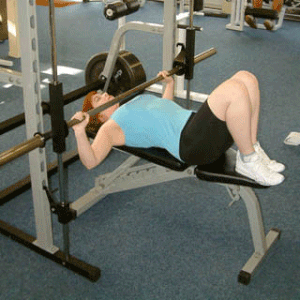
- The bench press is performed while lying face up on a bench, by pushing a weight away from the chest. This is a compound exercise that also involves the triceps and the front deltoids, also recruits the upper and lower back muscles, and traps.
- Equipment: dumbbells, barbell, Smith machine or bench press machine.
- Major variants: incline ~ (more emphasis on the upper pectorals), decline ~ (more emphasis on the lower pectorals), narrow grip ~ (more emphasis on the triceps), push-up (face down using the body weight), neck press (with the bar over the neck, to isolate the pectorals), vertical dips (using parallel dip bars) or horizontal dips (using two benches with arms on the near bench and feet on the far bench, and dropping the buttocks to the floor and pushing back up.)
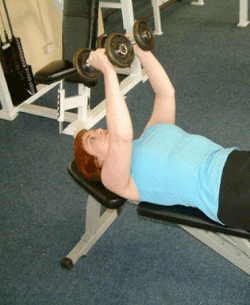
- The chest fly is performed while lying face up on a bench or standing up, with arms outspread holding weights, by bringing the arms together above the chest. This is a compound exercise for the pectorals. Other muscles worked include deltoids, triceps, and forearms.
- Equipment: dumbbells, cable machine or "pec deck" machine.
- Major variants: incline ~ (more emphasis on the upper pectorals), decline ~ (more emphasis on the lower pectorals), cable crossover.
Lats (lower back)

- The pulldown is performed while seated by pulling a wide bar down towards the upper chest or behind the neck. This is a compound exercise that also involves the biceps, forearms, and the rear deltoids.
- Equipment: cable machine or pulldown machine.
- Major variants: chin-up or pullup (using the body weight while hanging from a high bar), close grip ~ (more emphasis on the lower lats), reverse grip ~ (more emphasis on the biceps).
- The Pull-up is performed by hanging from a chin-up bar above head height with the palms facing forward and pulling the body up so the chin reaches or passes the bar. The pull-up is a compound exercise that also involves the biceps, forearms, traps, and the rear deltoids. A chin-up (palms facing backwards) places more emphasis on the biceps and a wide grip pullup places more emphasis on the lats. As beginners of this exercise are often unable to lift their own bodyweight, a chin-up machine can be used with counterweights to assist them in the lift.
- Equipment: chin-up bar or chin-up machine.
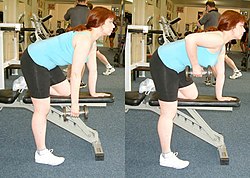
- The bent-over row is performed while leaning over, holding a weight hanging down in one hand or both hands, by pulling it up towards the abdomen. This is a compound exercise that also involves the biceps, forearms, traps, and the rear deltoids. The torso is unsupported in some variants of this exercise, in which case lifting belts are often used to help support the lower back.
- Equipment: dumbbell, barbell, Smith machine or T-bar machine.
- Major variants: cable row (using a cable machine while seated).
Deltoids (shoulders)
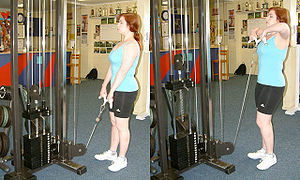
- The upright row is performed while standing, holding a weight hanging down in the hands, by lifting it straight up to the collarbone. This is a compound exercise that also involves the trapezius, upper back, forearms, triceps, and the biceps. The narrower the grip the more the trapezius muscles are exercised.
- Equipment: dumbbells, barbell, Smith machine or cable machine.
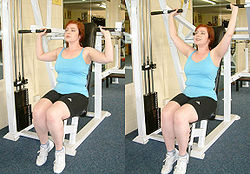
- The shoulder press is performed while seated, or standing by lowering a weight held above the head to just above the shoulders, and then raising it again. It can be performed with both arms, or one arm at a time. This is a compound exercise that also involves the trapezius and the triceps.
- The military press is similar to the shoulder press but is performed while standing with the feet together. (It is named "military" because of the similarity in appearance to the "at attention" position used in most militaries) Unlike the seated shoulder press, the military press involves the majority of the muscles of the core as stabilizers to keep the body rigid and upright, and is thus a more effective compound exercise.
- Equipment: dumbbells, kettlebells, barbell, Smith machine or shoulder press machine.
- Major variants: Arnold Press (dumbbells are raised while rotating the palms outwards).

- The lateral raise (or shoulder fly) is performed while standing or seated, with hands hanging down holding weights, by lifting them out to the sides until just below the level of the shoulders. A slight variation in the lifts can hit the deltoids even harder, while moving upwards, just turn the hands slightly downwards, keeping the last finger higher than the thumb. This is an isolation exercise for the deltoids. Also works the forearms and traps.
- Equipment: dumbbells, cable machine or lateral raise machine.
- Major variants: front raise (lift weights out to the front; emphasis is on the front deltoids), bent-over ~ (emphasis is on the rear deltoids).
Triceps (back of arms)
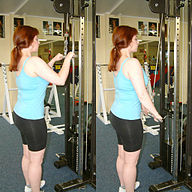
- The pushdown is performed while standing by pushing down on a bar held at the level of the upper chest. It is important keep the elbows at shoulder width and in line with shoulder/legs. In other words, elbows position should not change while moving the forearm pushes down the bar. This is an isolation exercise for the triceps.
- Equipment: cable machine or pulldown machine.
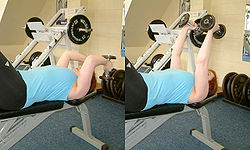
- The triceps extension is performed while standing or seated, by lowering a weight held above the head (keeping the upper arms motionless), and then raising it again. It can be performed with both arms, or one arm at a time. This is an isolation exercise for the triceps. It is also known as the french curl.
- Equipment: dumbbell(s), barbell, cable machine or triceps extension machine.
- Major variants: lying ~ (lying face up with the weights over the face), kickback (bent over with the upper arm parallel to the torso).
Biceps (front of arms)
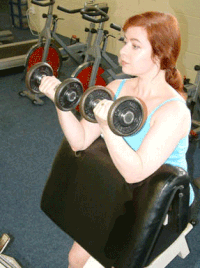
- The biceps curl is performed while standing or seated, with hands hanging down holding weights (palms facing forwards), by curling them up to the shoulders. It can be performed with both arms, or one arm at a time. for maximal hypertrophy 3 sets of 10 reps 2 mins between set
Waist


- Main article Abdominal exercise
- The crunch is performed while lying face up on the floor with knees bent, by curling the shoulders up towards the pelvis. This is an isolation exercise for the abdominals.
- Equipment: body weight, dumbbell or crunch machine.
- Major variants: reverse ~ (curling the pelvis towards the shoulders), twisting ~ or side ~ (lifting one shoulder at a time; emphasis is on the obliques), cable ~ (pulling down on a cable machine while kneeling), sit-up ~ (have chest touch your knees), vertical crunch (propping up to dangle legs and pulling knees to the chest or keeping legs straight and pulling up legs to a 90 degree position). Reverse hanging crunch (using gravity boots or slings to hang head down and pulling to a 90 or 180 degree form)
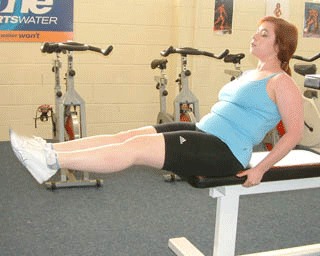
- The leg raise is performed while sitting on a bench or flat on the floor by raising the knees towards the shoulders, or legs to a vertical upright position. This is a compound exercise that also involves the hip flexors.
- Equipment: body weight or dumbbell.
- Major variants: hanging ~ (hanging from a high bar), side ~ (lying on side), knee raise (lying on back, drawing knees to chest).
Lower back
Back extension

The back extension is performed while lying face down partway along a flat or angled bench, so that the hips are supported and the heels secured, by bending down at the waist and then straightening up again. This is a compound exercise that also involves the glutes.
- Equipment
- Body weight, dumbbell or back extension machine.
- Major variants
- Without bench (lying face down on the floor).
Deadlift
The deadlift is a very effective compound exercise for strengthening the lower back, but also exercises many other major muscle groups, including quads, hamstrings and abdominals. It is a challenging exercise and not appropriate for beginners, as poor form or execution can cause serious injury.[12]
A deadlift is performed by grasping a dead weight on the floor and, while keeping the back very straight and looking up, standing up by extending the erector spinae (primary lower back muscle). When performed correctly the role of the arms in the deadlift is only that of cables attaching the weight to the body; the musculature of the arms should not be used to lift the weight. There is no movement more basic to everyday life than picking a dead weight up off of the floor, and for this reason focusing on improving one's deadlift will help prevent back injuries.
Good-morning
The Good-morning is a weight training exercise in which a barbell or two dumbbells are held on the shoulders, behind the head. The person bends forward and bows at the hips and recovers to upright. The good-morning is so called because the movement resembles bowing to greet someone. It involves the hamstrings but is primarily used to strengthen the lower back; the degree of knee bend used will change the focus – nearly straight-legged involving the hamstrings most.
External links
References
- ^ Johnson-Cane, Deidre (2000). The Complete Idiot's Guide to Weight Training. Indianapolis: Alpha Books. p. 169. ISBN 0-7865-4251-9.
{{cite book}}: Unknown parameter|coauthors=ignored (|author=suggested) (help) - ^ Johnson-Cane et al., p. 170
- ^ http://www.trulyhuge.com/squat-sponge.html
- ^ Johnson-Cane et al., p. 173.
- ^ a b Johnson-Cane et al., p. 172
- ^ Johnson-Cane et al., p. 175.
- ^ Johnson-Cane et al., p. 177.
- ^ Johnson-Cane et al., p. 179.
- ^ Johnson-Cane et al., p. 180.
- ^ Johnson-Cane et al., p. 181.
- ^ Johnson-Cane et al., p. 182.
- ^ Johnson-Cane et al., p. 187
